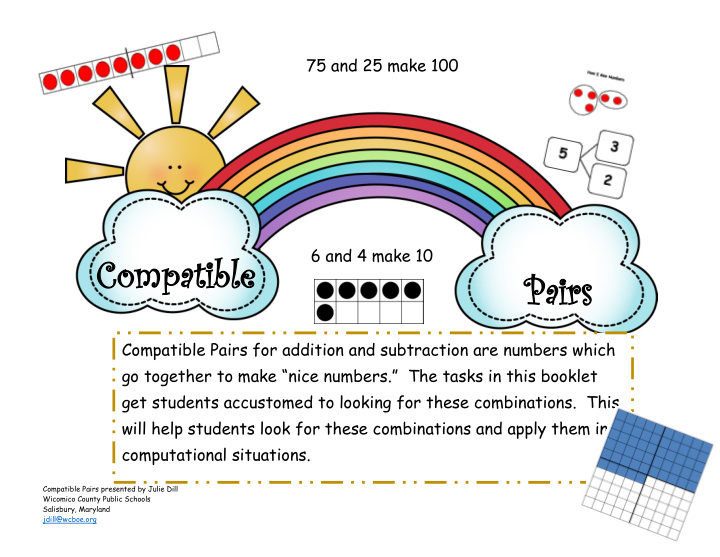



75 and 25 make 100 6 and 4 make 10 Com Compatible patible Pairs Pair Compatible Pairs for addition and subtraction are numbers which go together to make “nice numbers.” The tasks in this booklet get students accustomed to looking for these combinations. This will help students look for these combinations and apply them in computational situations. Compatible Pairs presented by Julie Dill Wicomico County Public Schools Salisbury, Maryland jdill@wcboe.org
The Other Part of Five Show a five frame to the students. Students tell you the number of dots they see and how many more is needed to make five. I see two dots. Three more dots would make five. Two and three make five. The Other Part of Ten Show a ten frame or a ten strip to the students. Students tell you the number of dots they see and how many more is needed to make ten. I see six dots. Four more dots would make ten. Six and four make ten. I see eight dots. Two more dots would make ten. Eight and two make ten.
Two Out of Three Directions: Flash the cards to students. They select the two numbers that make ten. Extend to select the two numbers that make 100. 4 50 3 6 20 80
The Other Part of 100 Preparation: Copy the blank hundred board for each pair of students. Cut out colored, transparent plastic strips the same length as a row in the hundred board. Cut some of these strips into squares the same size as the squares on the hundred board. These strips will represent the tens and ones for the activity. Materials: For each pair of students you will need - place value dice. 1 tens and 1 ones, a blank hundred board, colored, plastic strips and squares Directions: Student one rolls the tens and ones dice. They take the corresponding strips and squares for the number rolled. Then the student should cover the blank hundred board showing the number rolled. Student two states the number for the uncovered part of the hundred board. Students compare the numbers. The student with the largest amount states or writes the equation which makes 100. Blank Hundred Board Student 1: I rolled 4 tens and 7ones, so I covered 47 on the board. Student 2: Then 53 is uncovered. 53 is greater so the equation is 47 + 53 = 100
Blank Hundred Board
How I See Numbers This activity combines subitizing with number bonds. Prepare laminated sets of cards with dot patterns. Ask students how many dots they see and how do they see them. Ask them to circle the groups they see. Record the parts and the whole in the number bonds. You may also extend this to writing equations which represent the number of dots they see.
How I See Numbers
FIDDLE STICKS 1 Arrange them in order, find patterns in numbers, and fiddle with them! Use these sticks to make sets of numbers that add up to 8, 9 or 10 or even higher! 2 3 4 5 6 7 8 9 10
References Sztajin, Paola. Celebrating 100 with Number Sense. Teaching Children Mathematics, December 2002. Van de Walle, John . The Early Development of Number Relationships. Teaching Children Mathematics, February 1988. Van de Walle, John. Teaching Student - Centered Mathematics Grades K - 3. Pearson, 2006. Howden, H. Teaching Number Sense . Arithmetic Teacher, 1989. Compatible Pairs presented by Julie Dill Math Professional Development Coach Wicomico County Public Schools Salisbury, Maryland jdill@wcboe.org www.math4u.wicomico.wikispaces.net
Recommend
More recommend